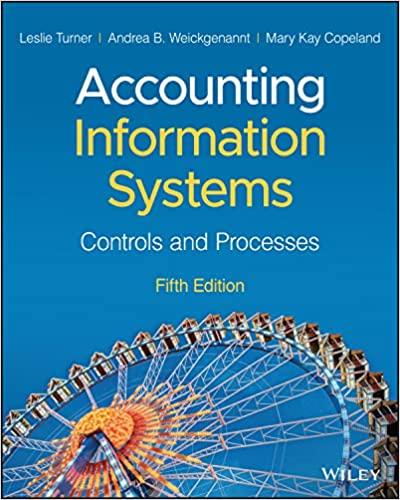Please answer question No.4.
Exhibit 1: DDM Lab 2020 Financial Results Revenues 4,576,023.4 Direct Labour 1,788,242.3 Overhead 2,775,399.2 Total Expenses 4,563,641.5 Profit 12,381.9 Exhibit 2: Calculation of the cost rate at DDM Lab Overhead 2,775,399.20 Direct Labour 1,788,242.30 Cost rate 1.55 Exhibit 3: DDM Lab Direct Labour Cost Breakdown by Test Test Direct labour $ Projectional Radiographs 542,194.9 Flouroscopies 538,261.1 CAT Scan 352,105.0 MRIScan 355,681.3 1,788,242.3 Exhibit 4: Additional information required for cost system proposed by accountant Type of Overhead Cost Cost Direct Labour Related Overhead 1,009,948.8 Equipment Related Overhad 1,765,450.4 Total overhead 2,775,399.2 Utilization of equipment Projectional Radiographs Flouroscopies CAT Scan MRI Scan Run time/vear (hours) 1,431.00 1,771.20 1,881.90 3,395.25 8,479.35 Exhibit 5: Additional information required for cost system proposed by consultant Type of overhead cost Cost High tech 1,290,510.2 Low tech 474,940.2 1,765,450.4 Utilization of high- and low-tech equipment by test in hours per year Test High-tech Low-tech Projectional Radiographs 361.80 1,069.20 Flouroscopies 781.65 989.55 CAT Scan 1,105.65 776.25 MRI Scan 3,395.25 0.00 5,644.35 2,835.00 8. THE END OF CASE STUDY 4. Calculations & Interpretations - Quantitative Analysis (15 marks) This section requires you to undertake quantitative analysis on the case. You are to perform calculations that are relevant to the problem and issues that you identified in Section 2. In particular: 1. Calculate the product cost for each of the four tests in accordance with: The existing one-pool costing system (3 marks) The two-pool costing system proposed by Nina Kastelic, the accountant (4 marks) The three-pool costing system proposed by Micheal Postman, the consultant (4 marks) 2. Consider DDM Lab's recent investment in 3D MRI equipment. While it allows DDM Lab to stay at the forefront of technological developments, it is currently underutilised. Make additional analyses to understand how the costs per test change in relation to a 100% utilisation of the MRI scanner. (4 marks) Exhibit 1: DDM Lab 2020 Financial Results Revenues 4,576,023.4 Direct Labour 1,788,242.3 Overhead 2,775,399.2 Total Expenses 4,563,641.5 Profit 12,381.9 Exhibit 2: Calculation of the cost rate at DDM Lab Overhead 2,775,399.20 Direct Labour 1,788,242.30 Cost rate 1.55 Exhibit 3: DDM Lab Direct Labour Cost Breakdown by Test Test Direct labour $ Projectional Radiographs 542,194.9 Flouroscopies 538,261.1 CAT Scan 352,105.0 MRIScan 355,681.3 1,788,242.3 Exhibit 4: Additional information required for cost system proposed by accountant Type of Overhead Cost Cost Direct Labour Related Overhead 1,009,948.8 Equipment Related Overhad 1,765,450.4 Total overhead 2,775,399.2 Utilization of equipment Projectional Radiographs Flouroscopies CAT Scan MRI Scan Run time/vear (hours) 1,431.00 1,771.20 1,881.90 3,395.25 8,479.35 Exhibit 5: Additional information required for cost system proposed by consultant Type of overhead cost Cost High tech 1,290,510.2 Low tech 474,940.2 1,765,450.4 Utilization of high- and low-tech equipment by test in hours per year Test High-tech Low-tech Projectional Radiographs 361.80 1,069.20 Flouroscopies 781.65 989.55 CAT Scan 1,105.65 776.25 MRI Scan 3,395.25 0.00 5,644.35 2,835.00 8. THE END OF CASE STUDY 4. Calculations & Interpretations - Quantitative Analysis (15 marks) This section requires you to undertake quantitative analysis on the case. You are to perform calculations that are relevant to the problem and issues that you identified in Section 2. In particular: 1. Calculate the product cost for each of the four tests in accordance with: The existing one-pool costing system (3 marks) The two-pool costing system proposed by Nina Kastelic, the accountant (4 marks) The three-pool costing system proposed by Micheal Postman, the consultant (4 marks) 2. Consider DDM Lab's recent investment in 3D MRI equipment. While it allows DDM Lab to stay at the forefront of technological developments, it is currently underutilised. Make additional analyses to understand how the costs per test change in relation to a 100% utilisation of the MRI scanner. (4 marks)









